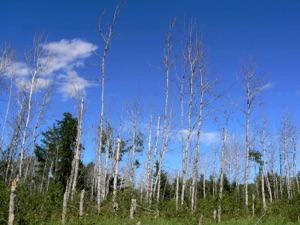Assessing ecosystem resistance and recovery after extreme drought-related dieback events

Temperatures are rising and will continue to rise across the globe as a consequence of human induced changes in climate. Precipitation patterns are also being affected, though the pattern of change is less easy to predict. In many areas of the world, rising temperatures are not being matched by increases in precipitation, which results in increasing impacts of drought on the plants, animals and people that live in such places.
One of the consequences of this drought increase is that large-scale dieback events are occurring in forest and shrubland systems across the world. In these events, trees and shrubs are often killed over large areas, sometimes tens to hundreds of square kilometers, either by the drought itself or through outbreaks of insect pests on the drought-weakened trees. Often dieback affects some species and not others, so forest and shrubland composition can change rapidly.
Effects of these dieback events are sudden and widespread and can include soil loss, since the trees and shrubs no longer bind the soils together with their roots, and increased fire risk as the dead trees and shrubs provide an abundant fuel source. Such types of events are predicted to happen more often as the climate continues to warm, putting plants and animals at risk of death and habitat loss and posing considerable risk to local human populations
This Leverhulme Trust funded project draws together researchers from the USA, Argentina, Australia, Spain and the UK to take a global overview of extreme drought-linked dieback from a plant community perspective. We will be assessing which types of forests and shrublands are most at risk from such widespread dieback events and the changes that occur when the drought passes and the ecosystem begins to recover. We will investigate how plant communities have developed on the sites of past dieback events and look for similarities between the types of trees and shrubs that are able to recolonize or recover compared to those that don’t.
By assessing the characteristics of the communities that establish after dieback in contrast with the ones that existed before, we also aim to identify what the consequences of such changes will be in the long term, both for the species occurring in such systems and the humans that depend on them.
Eucalyptus melanophloia savanna after a drought culminating in 2004.
Photo: Rod Fensham
Related publications
Ruiz-Benito P, Ratcliffe S, Zavala MA, Martinez-Vilalta J, Vila-Cabrera A, Lloret F, Madrigal-González J, Wirth C, Greenwood S, Kändler G, Lehtonen A, Kattge J, Dahlgren J, Jump AS (2017) Climate- and successional-related changes in functional composition of European forests are strongly driven by tree mortality. Global Change Biology, 23, 4162-4176
Jump AS, Ruiz-Benito P, Greenwood S, Allen CD, Kitzberger T, Fensham F, Martínez-Vilalta J, Lloret F (2017) Structural overshoot of tree growth with climate variability and the global spectrum of drought-induced forest dieback. Global Change Biology, 23, 3742-3757
Greenwood S, Ruiz-Benito P, Martínez-Vilalta J, Lloret F, Kitzberger T, Allen CD, Fensham R, Laughlin DC, Kattge J, Bönisch G, Kraft NJB, Jump AS (2017) Tree mortality across biomes is promoted by drought intensity, lower wood density and higher specific leaf area. Ecology Letters, 20, 539-553
Allen, CD, Breshears DD, McDowell NG. (2015). On underestimation of global vulnerability to tree
mortality and forest die-off from hotter drought in the Anthropocene. Ecosphere 6(8):129. DOI: 10.1890/ES15-00203.1
Ruiz-Benito P, Madrigal-González J, Young S, Mercatoris P, Cavin L, Huang T-J, Chen J-C, Jump AS (2015) Climatic stress during stand development alters the sign and magnitude of age-related growth responses in a subtropical mountain pine. PLOS One DOI: 10.1371/journal.pone.0126581
Ruiz-Benito P, Madrigal-González J, Ratcliffe S, Coomes DA, Kändler G, Lehtonen A, Wirth C, Zavala MA (2014). Stand structure and recent climate change constrain stand basal area change in European forests: a comparison across boreal, temperate and Mediterranean biomes. Ecosystems, 17, 1439-1454
Ruiz-Benito P, Herrero A, Zavala MA (2013). Vulnerabilidad de los bosques Ibéricos frente al cambio climático: evaluación mediante modelos. Ecosistemas, 22, 21-28.
Jump AS, Mátyás C, Peñuelas J (2009). The altitude-for-latitude disparity in the range retractions of woody species. Trends in Ecology and Evolution, 24, 694-701.

Photo: Ted Hogg
